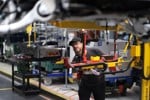A successful sustainable mobility strategy requires strong partnerships, data analysis and a top-down commitment to change.
Electric vehicles (EVs) have a big part to play, but behavioural changes are also needed if fleets wants to reach zero-emission status.
Speaking at Fleet and Mobility Live, Amelie De Valroger, global director of electric solutions and consultancy at Ayvens, explained to delegates that electrification is the first driver towards decarbonisation but there are many more things to consider beyond replacing vehicles.
She said: “When we talk about climate , we can all agree that the future is challenging and also the road is bumpier than expected.”
In the current market, electrification is slowing down. Issues with vehicle supply, rising energy costs and uncertainty over residual values is affecting sales growth.
TCO is much more volatile, surging by 20% during the Covid pandemic. Car makers have since cut list prices, as a result of slow sales and increased competition, in a bid to increase EV sales so they can hit Government mandated targets.
De Valroger said EVs have now reached cost parity with BEVs as a result these price cuts, according to Ayvens data, and incentives such a reduced benefit-in-kind tax helps make EVs more desirable to drivers. Challenges still remain around the availability of suitable charging infrastructure and the cost of charging, however.
Ayvens wants to make the EV transition simple, intuitive and accessible. This includes taking a consultative approach to define a bespoke fleet strategy for each customer.
De Valroger explained the importance of rightsizing by switching drivers into smaller cars or cars from different brands. This way, fleets can ensure their TCO costs are maintained or reduced during the adoption of new vehicles. She also encouraged operators to consider longer leases.
Defra Group Fleet Services has already implemented a sustainable mobility policy and, since 2020, has reduced its fleet emissions by 45%.

During the session, Dale Eynon, fleet director at Defra, gave some real-world examples of how he achieved this across his fleet of circa 9,000 assets.
He said there’s four elements in any strategy to get a sustainable mobility strategy in place: Reducing emissions, shared mobility, public transport and smart mobility.
The first step for Defra was to move all its company cars to EVs. Eynon explained that this was quite straightforward but larger vans and trucks pose a bigger challenge
By using vehicles less, emissions are autonomically reduced. This can be through better utilisation and sharing, or simply by using other methods of transport.
Defra encourages its employees to use active transport, such as cycling and walking where possible. It also promotes shared mobility, using car clubs, car sharing and ride sharing services.
Some of these options can be challenging for businesses that are not based in urban environments, Eynon pointed out.
With a target of having a 100% zero-emission fleet by 2027, Defra still faces some challenges.
Eynon said: “Sustainable mobility in a lot of cases is about those that can afford to protect the environment. Lots of options are expensive and need to be more affordable.”
He explained that everyone must be treated equally and the experience for employees must be seamless and easy.
























Login to comment
Comments
No comments have been made yet.